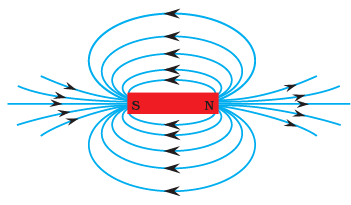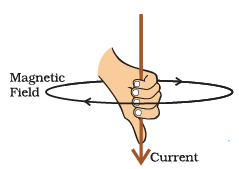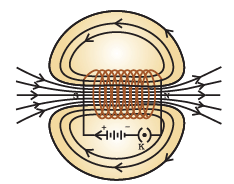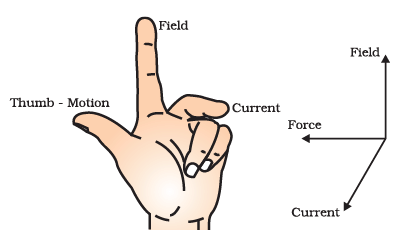Diagram Based Questions: Magnetic Effects of Electric Current | Science Class 10 PDF Download
Q1: Answer the following questions based on the diagram given below:

(i) What is the shape of the magnetic field lines around a bar magnet, as shown in the experiment?
Ans: The magnetic field lines around a bar magnet form closed loops, extending from the north pole to the south pole.
(ii) How can you determine the direction of the magnetic field lines using the experiment?
Ans: You can determine the direction of magnetic field lines using a small compass needle. The direction in which the compass needle points at any location around the magnet shows the direction of the magnetic field line at that point.
(iii) What do the field lines inside the magnet look like, based on the diagram?
Ans: Inside the magnet, the magnetic field lines run from the south pole to the north pole in a curved path.
(iv) How does the spacing of magnetic field lines indicate the strength of the magnetic field?
Ans: The closer the magnetic field lines are to each other, the stronger the magnetic field is at that point. The spacing of field lines is a visual representation of the field's strength.
(v) Why do magnetic field lines never cross each other?
Ans: Magnetic field lines never cross each other because if they did, it would imply that a single point in space has two different directions of magnetic field, which is not possible. The absence of crossings ensures that each point has a unique direction for the magnetic field.
Q2: Answer the following questions based on the diagram given below:

(i) What is the Right-hand thumb rule used for in the context of electricity and magnetism?
Ans: The Right-hand thumb rule is used to determine the direction of the magnetic field around a current-carrying conductor.
(ii) Describe the setup of an experiment where the Right-hand thumb rule can be applied.
Ans: To demonstrate the Right-hand thumb rule, you can set up an experiment with a straight current-carrying wire. Place your right thumb in the direction of the current flow (from positive to negative), and your fingers will curl in the direction of the magnetic field lines around the wire.
(iii) If the current in a wire flows from north to south and you use the Right-hand thumb rule, what direction will the magnetic field lines wrap around the wire?
Ans: Using the Right-hand thumb rule, the magnetic field lines will wrap around the wire in a clockwise direction when viewed from the top.
(iv) How does the strength of the magnetic field change with the increase in current in the wire when applying the Right-hand thumb rule?
Ans: When the current in the wire increases, the strength of the magnetic field, as indicated by the curvature of the magnetic field lines when using the Right-hand thumb rule, also increases. They become more tightly wound around the wire.
(v) Can you explain a real-life application of the Right-hand thumb rule?
Ans: Sure! One practical application of the Right-hand thumb rule is in designing electromagnets. Engineers use this rule to determine the direction of the magnetic field within the coil of an electromagnet, ensuring it aligns with the intended purpose, such as picking up metal objects in a junkyard or controlling the movement of particles in a particle accelerator.
Q3: Answer the following questions based on the diagram given below:
(i) What is a solenoid in the context of electricity and magnetism?
Ans: A solenoid is a long, tightly wound coil of wire. It is used to generate a magnetic field when an electric current passes through it.
(ii) How does the magnetic field inside a solenoid compare to the magnetic field outside it?
Ans: Inside a solenoid, the magnetic field is strong and uniform, running parallel to the coil's axis. Outside the solenoid, the magnetic field is weak and resembles the field lines of a bar magnet, forming closed loops.
(iii) Explain why the magnetic field lines around a solenoid are concentrated inside the coil.
Ans: The magnetic field lines are concentrated inside the solenoid because the turns of wire are closely packed together. This arrangement amplifies the magnetic field strength within the coil while minimizing it outside.
(iv) If the current flowing through a solenoid is increased, what happens to the strength of the magnetic field inside it?
Ans: When the current through a solenoid is increased, the strength of the magnetic field inside it also increases. This is because the magnetic field strength is directly proportional to the current passing through the solenoid.
(v) How does the direction of the magnetic field inside a solenoid relate to the direction of the current flowing through it?
Ans: The direction of the magnetic field inside a solenoid is along the axis of the coil, and it follows the right-hand thumb rule. If you point your right thumb in the direction of the current flow, your fingers will curl in the direction of the magnetic field lines inside the solenoid.
Q4: Answer the following questions based on the diagram given below:
(i) What is Fleming's left-hand rule used for?
Ans: Fleming's left-hand rule is used to determine the direction of the magnetic force experienced by a current-carrying conductor in a magnetic field.
(ii) Explain the three main factors involved in Fleming's left-hand rule.
Ans: The three main factors are:
- The thumb points in the direction of the motion (the current).
- The forefinger points in the direction of the magnetic field.
- The middle finger points in the direction of the magnetic force experienced by the conductor.
(iii) In Fleming's left-hand rule, what does the thumb represent?
Ans: In Fleming's left-hand rule, the thumb represents the direction of the current (motion) in the conductor.
(iv) What does the forefinger indicate in Fleming's left-hand rule?
Ans: The forefinger in Fleming's left-hand rule indicates the direction of the magnetic field lines in which the conductor is placed.
(v) How can you determine the direction of the magnetic force using Fleming's left-hand rule?
Ans: To determine the direction of the magnetic force on a current-carrying conductor, align your left hand so that your thumb represents the direction of current, your forefinger indicates the direction of the magnetic field, and your middle finger will point in the direction of the magnetic force experienced by the conductor.
|
80 videos|569 docs|80 tests
|
FAQs on Diagram Based Questions: Magnetic Effects of Electric Current - Science Class 10
| 1. What is the right-hand rule for determining the direction of the magnetic field around a current-carrying wire? |  |
| 2. How does the strength of the magnetic field produced by a current-carrying wire change with the distance from the wire? |  |
| 3. Can the direction of the magnetic field be reversed by changing the direction of the current flow in a wire? |  |
| 4. How does the magnetic field around a coil of wire differ from the magnetic field around a straight wire carrying the same current? |  |
| 5. What is the significance of the term 'magnetic declination' in the context of magnetic effects of electric current? |  |
















